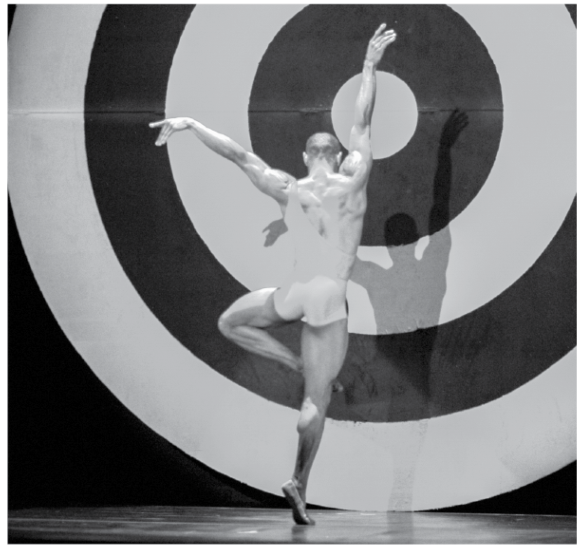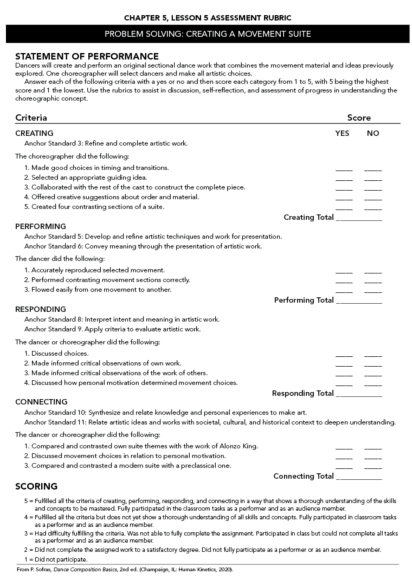Problem Solving: Creating a Movement Suite
This is an excerpt from Dance Composition Basics 2nd Edition With Web Resource by Pamela Anderson Sofras.
During the five chapters of this book, dancers have been challenged to reach toward the target of dance composition. In this final assignment, dancers will meet their target like Uri Sands meets the target in Verge, with energy and grace, knowing that the end of this journey is near.
Vocabulary
allemande
contrast
courante
duple meter
galliard
gigue
optional dance
pavane
saraband
suite
tempo
theme
triple meter

Uri Sands confronting the target from Dwight Rhoden's Verge.
© Rolland Elliott
Introductory Statement
Historically, the suite was a sectional form of instrumental music that accompanied dance. It consisted of individual, separate pieces, performed one after the other, that were based on the same musical theme and were played in the same key. For the sake of variety, suites followed this pattern: a slow dance (in the Renaissance and earlier times it was called basse danse) followed by a faster, jumpy dance (haute danse). In the early 17th century, the dances that fitted that mold were the pavane, in slow duple meter, and the galliard, in fast triple meter. By the end of the 17th century, the suite followed this highly stylized schema:
Allemande (moderate tempo, in 4/4)
Courante (moderately fast, in 6/4)
Saraband (very slow, in 3/4)
Gigue (very fast, in 6/8, compound time)
Often different dances, also called optional dances, were included between the four basic dances. Such dances included the minuet (3/4), gavotte (2/4), and bourree (2/4), among others.
The convention for presenting the overall form of each dance was as follows: A (the first section of the piece, presenting the theme) followed by B (the second section, which developed in a contrasting way to theme A). Therefore, the scheme read as AB. Often each section was repeated as AABB. Sections A and B might have the same number of musical measures, or B could have a few more musical measures.Throughout the lessons in this book, dancers have used AB form and contrasting movement materials to build their studies, such as in chapter 2, lesson 2; chapter 3, lesson 4; and chapter 4, lesson 2.
After 1750 the traditional Baroque suite became extinct. It was absorbed by common classical forms such as the divertimento, cassation, and sonata. Revivals of the suite as a musical form occurred in the late 19th century and even reappeared in the 20th century. In dance, suites are often used by contemporary choreographers who wish to create abstract, sectional dance works. Alonzo King's Chants is an example of a work in suite form. The work is accompanied by different African songs and chants. The order of the songs and the dance sections were chosen by King and reflect contrasting tempos and qualities. The sections are quite different from each other and they feature anything from large-group dances with many voices accompanying the movement, to solos and duets with only one or two singers.
Following the form of the dance suite and inspired by Chants, dancers will create group works that are made up of two to four independent contrasting sections, alternating slow and fast. Each section should use movement phrases and dynamics and groupings that are different from the previous section.
The work should have a central theme to guide movement choices, but the theme can be abstract or nonliteral, such as colors, environments, animals, birds, or creatures in the sea.
Problem Solving
Example: Chapter 5, Lesson 5A: Suite From Chants (Excerpts)
Included in this example are four sections from Alonzo King's Chants. The sections are not in the order of the original dance but have been placed in this order to provide a model for the creative problem that follows. Alonzo King's original suite included 10 different dance sections.
The selected sections are as follows:
- “N'Diouk Tabala Wolof”—A quick men's dance in varied rhythms
- “Yofo Yo”—A weight-sharing, counterbalanced duet for two women
- “N'terole”—A solo featuring acceleration in music and dance
- “Women of Butela”—A quick dance for women, alternating solo with group
- One choreographer will choose a cast of four to six dancers to create a suite of four separate sections. All of the class members should have a role as either choreographer or dancer. If necessary, dancers from outside the class may be used so that all choreographers have four to six dancers as a cast. A movement theme should guide the development of the movement ideas and the choice of music. Each choreographer should use movement material or choreographic operations developed in previous chapters of this book.
Section 1. Quick; full-group dance; duple in 4s.
AB form with two separate types of movement. Choreographers may wish to construct movement sentences of different action words to assure variety.
Section 2. Slow; duet; triple in 3s.
Theme and variations (A, A1, A2, A3, A).
Shapes and sharing weight.
Section 3. Trio; combination of different pulses; duple using half time and double time.
Locomotor and nonlocomotor movement should be designed for each dancer but each dancer should dance to a different beat (pulse, half time, double time).
Section 4. Full group dancing, accelerating and retarding movement; phrases are duple or triple. This is followed by (A) selected gestures evolving into movement phrases showing different movement qualities, and (B) creating an AB form with two types of movement. The theme of the B subsection should take a longer amount of time to complete in order to create a closing for the work. There may be a retard at the end of the work to allow for an ending.
- Assess the process by making a video recording of the work. Watch and critique the work, discussing compositional choices.


More Excerpts From Dance Composition Basics 2nd Edition With Web Resource
SHOP

Get the latest insights with regular newsletters, plus periodic product information and special insider offers.
JOIN NOW


